Westoning Church Repairs and Additions
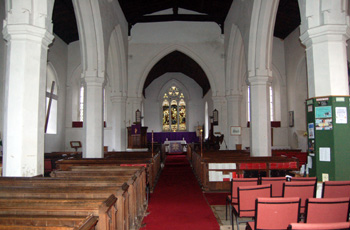
The interior looking east February 2010
Much of the structural history of the church can be found in detail in Bedfordshire Historical Record Society Volume number 79 of 2000 Bedfordshire Churches in the Nineteenth Century: Part III: Parishes S to Y put together by former County Archivist Chris Pickford from numerous sources some held by Bedfordshire & Luton Archives & Records Service and some held elsewhere or published. The more modern story can be found in the excellent church guide written by Bernard Anderson in 1997 and updated in 2005.

The interior looking west February 2010
An inventory of 1552 lists the plate and valuables and states that the chancel steeple and porch were covered with lead. In 1629 William Rawlins left money for "a cloth and carpet for the communion table and a long cushion and a faire pulpit cloth", he insisted that the pulpit cloth should have his name on it [P16/1/2]. In 1672 a fifth bell was added to the medieval bells. New plate was provided in 1685 [ABE5]

Pulpit February 2010
One of the bells was recast in 1722. From 1743 expenditure on the church is recorded in the churchwardens' accounts. Two bells were recast by Thomas Russell of Wootton in 1743 [P16/5/1]. In 1753 the pulpit was painted and a new pulpit cloth and cushion were provided [P16/5/1]. Repairs to the leadwork on the roof were carried out in 1779-81 at a cost of £32. The leaded spire was repaired in 1785 and the accounts recorded a gift of sixpence to "the workmen having a difficult job on the steeple" [P16/5/1]. Further roof repairs were done between 1787-1795. In 1799 the ten commandments were set up in the chancel arch by John Carte [P16/5/1].
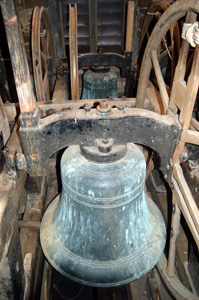
The tenor bell February 2010
The bells were rehung by John Farmer in 1805 and in 1807-9 repairs costing £35 were carried out by Drew and Carte [P16/5/1]. In 1810 the church clock was repaired or replaced. In 1812 a new paten [plate for the consecrated bread] dated 1777 was added to the plate. In about 1815 a "rough temporary gallery" was built with the name of the churchwarden William Woodward, painted on the front. The accounts also mention a robbery in 1822.

View of the north aisle east window February 2010
The accounts refer to getting the church ready for Archdeacon Bonney's visitation in 1823 and the volume contains a note on the laws regarding pews and the duties of churchwardens entered "by order of the archdeacon" in 1825 [P16/5/1]. Several of the furnishings listed in the 1825 terrier had been replaced or repaired in response to Bonney's orders, and in 1824-5 repairs to the church were carried out at a cost of £87 [P16/5/1]. This included the enlargement of the west gallery. The later accounts refer to the purchase of new hassocks in 1828-9, the recasting of the third bell in 1829, repairs by William Hindes in 1837-8 [P16/5/1] and some minor work in 1850 [P16/5/3].
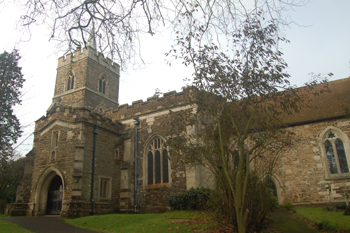
The church from the south-east January 2010
‘W.A.’ (John Martin, who wrote a series of articles on Bedfordshire churches) wrote an article on the church in the Northampton Mercury of 2nd August 1845 and criticised the "neglected" condition of the church. His remarks seem to be at odds with other sources which suggest that the church was well maintained. His piece is as follows: "This church was in a very neglected state; the dirty condition which it exhibited, and for which there can be no excuse, must disgust every one, even those who are indifferent to Church architecture. It seemed in character with the dirty channel, and stagnant water, which you pass in your way from the high road to the Church. White washing, however, had not been neglected, and it had been so perseveringly applied that the mouldings were nearly obliterated. In the porch especially this was the case, where the windows, apparently very good specimens, had been bricked up. Why this was done we are at a loss to conjecture, more especially as there is a miserable wooden gate to prevent the
"Offering a sunny place to them
Who deck the house of worship".
The wooden roof remained, but a gallery of the most unsightly description ran along the whole of the western entrance. The arch was boarded up, the western light, of course, excluded. The originator of this disfigurement had thought so well of his work as to record his name [William Woodward, see above]. There were none of the original sittings left, but the "lidless boxes" prevailed over them, one of which almost entirely excluded an apparently very good niche. The font was painted. The chancel was in as dirty condition as the rest of the building. The wooden roof remained, the crown of the arch had been boarded up, for the purpose it is presumed of placing in the wrong situation, the ten commandments &c., badly executed [by John Carte, see above]. Over the centre of the miserable communion table, some former incumbent had had the bad taste to erect a tablet in memory of himself and wife. We hope the Venerable Archdeacon, on his next visitation, will order it to be removed. There are two large pews in the chancel not much better, and equally offensive as the other boxes for which this portion of the sacred edifice appeared to be the receptacle. The lead on the roof had not been removed. The Church-yard was in a neglected state".
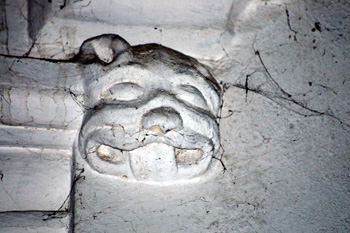
Head on the north side of the west tower arch February 2010
He did not go unanswered, J. D, Parry wrote to the Northampton Mercury on 30th August 1845 to refute the claim against Rev. Whitehurst, whom he took to be the recipient of Martin's words about the memorial tablet. There is no tablet to Whitehurst in the chancel today.
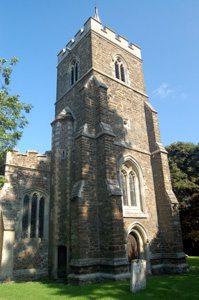
Westoning church from the west August 2009
In 1857 the church was completely restored under William Slater at a cost of £1,757. The work involved repairs to the stonework and roofs, a new roof on the chancel, the addition of a vestry and a new stair turret on the tower. The west gallery and the commandment boards in the chancel arch were also taken down at the time of the restoration [P16/5/2].
![The nave looking east about 1900 [Z1130]](/CommunityHistories/Westoning/WestoningImages/The nave looking east about 1900 [Z1130].jpg)
The nave looking east about 1900 [Z1130]
Further work on the church took place in 1893 after an appeal was launched to meet the cost of repairs and improvements [P16/2/2/1-2 and P16/5/2]. Lamps were provided "to make evening service possible", the stonework was repaired in 1893 by Samuel Foster of Kempston, and in 1894 the bells were rehung in a new frame [P16/2/2/1]. At the same time chancel improvements were undertaken by J.G. Coventry Campion who, in 1895, placed stained glass in the east window in memory of his parents.
![The chancel looking east about 1900 [Z50/130/4]](/CommunityHistories/Westoning/WestoningImages/The chancel looking east about 1900 [Z50-130-4].jpg)
The chancel looking east about 1900 [Z50/130/4]
In 1903 a further stained glass window was placed in the south aisle. One of the bells was recast in 1903 and in 1923 a sixth bell was added. The oak eagle lectern was presented by Mrs Newland in 1908. In 1920 a stove in the church was replaced by a more efficient example, at a cost of £8/13/-. Electricity was installed in the church in 1932 for a total cost of £147.
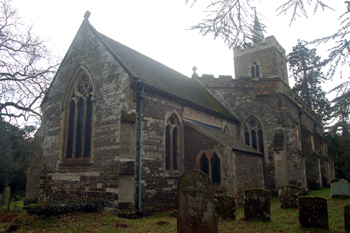
The church from the north-east January 2010
The tower and steeple were badly damaged by lightning in 1938. By 1947 the chancel walls needed underpinning due to faults in the sub-soil exacerbated by drought and this was carried out in 1948. The discovery of death watch beetle in 1958 resulted in a restoration costing in excess of £3,000. The lighting in the church was replaced in the following year. A new, electric, organ was purchased in 1961 and in the same year hot air heating was installed at a cost of £781.

Stairs up to the room above the porch February 2010
In 1966 the vestry and chancel were re-roofed at a cost of over £500. Pews in the south aisle were removed in 1979 to form a creche and access to the priest's room over the porch was reopened at this time. This subsequently became a habitat for bats and is currently [2010] being restored.
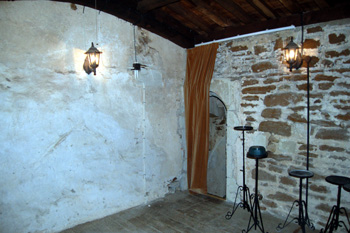
The room above the porch February 2010
In 1981 lead was stolen from the nave roof and an inspection revealed that the roof needed to be shored up as it was in a very poor state. Pew panel heaters were installed in 1986. The organ was completely rebuilt in 1990. Finally, thanks to grants, the nave roof was restored in 1996. Today the church is very well kept and even W. A. might find little to grouse about.

The tombstone of Thomas Breade February 2010
To the east of the east wall of the chancel, in the churchyard, lies a headstone to Thomas Breade, wjo died in 1716. It was listed by the former Department of Environment and is made of limestone which is now extensively weathered and covered in lichen and moss, making the inscription very difficult to read. It says:
The world is nothing, Heaven all
I have lost nothing by my fall.
Go tell my Friends when they do weep
I am not dead but gone to sleep.
The entrance to the churchyard has a memorial to a more recent passing. There is a memorial plaque to Corporal David Robert Howes of the Royal Signals who was killed by terrorists in Belfast in March 1988.
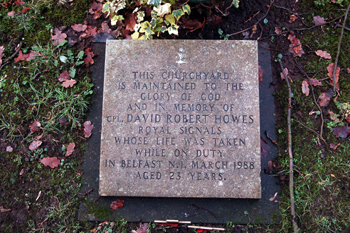
Memorial plaque to David Robert Howes in the churchyard January 2010